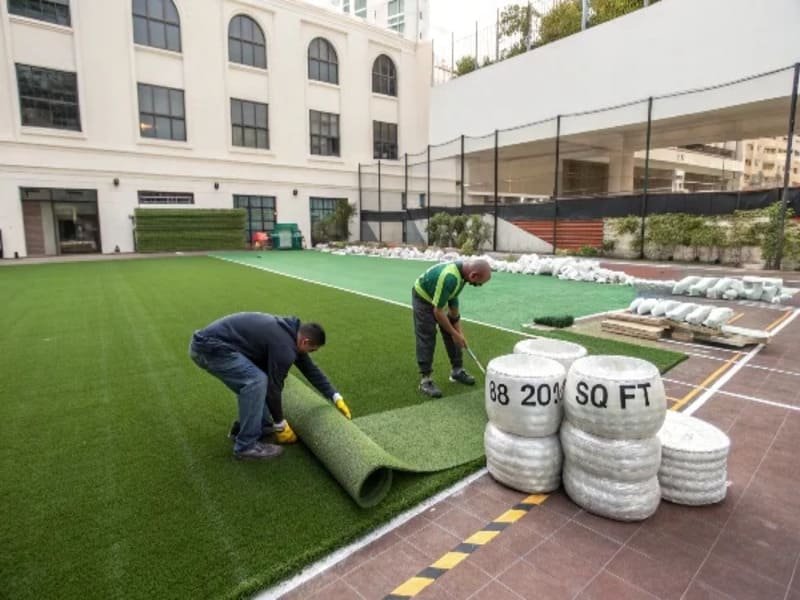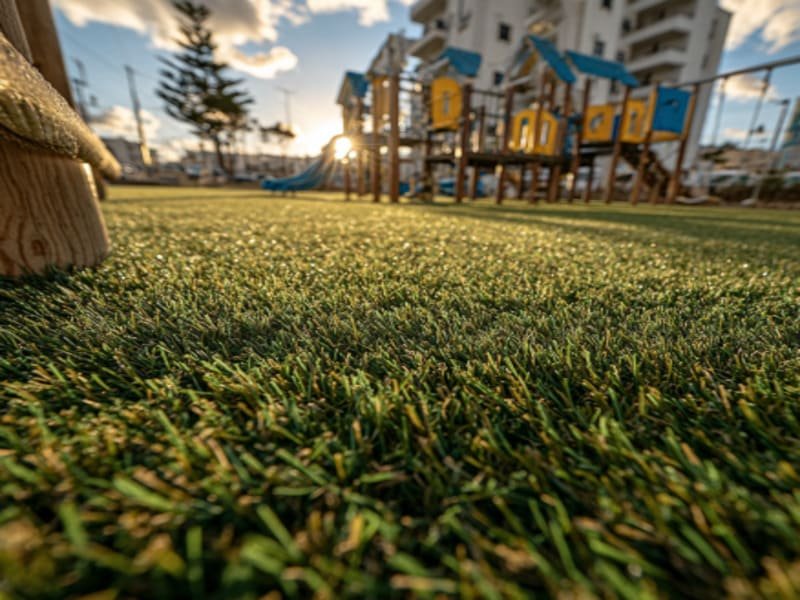Installing artificial turf for a playground involves careful ground preparation, precise turf laying techniques, and proper infill application. By following best practices and safety standards, you can create a durable, cushioned surface that will provide years of enjoyment for children.

Artificial turf offers many advantages over traditional playground surfaces. It provides a consistent, cushioned surface for kids to play on while requiring minimal maintenance. Playground turf is an excellent choice for its durability, safety features, and low upkeep needs. It can withstand heavy foot traffic, harsh weather, and constant use while providing a soft, even surface that reduces injury risk.
Benefits of Artificial Turf for Play Areas
- Durability: High-quality artificial turf is designed to endure active play without breaking down or developing holes. It can last up to 15 years with proper care.
- Safety: Artificial turf can be installed with shock-absorbing padding and infill to create a cushioned surface that meets safety standards like ASTM F1292 and EN1177. This minimizes the impact of falls.
- Low Maintenance: Unlike natural grass, artificial turf doesn’t require mowing, watering, or fertilizing. It stays green and lush with occasional brushing and rinsing.
- All-Weather Use: Turf drains quickly after rain and doesn’t form puddles, allowing kids to play sooner. It stays cooler than asphalt or concrete on hot days.
- Accessibility: Artificial turf provides a stable, even surface that accommodates wheelchairs and mobility devices better than loose-fill materials like wood chips or sand.
When selecting turf for a playground, look for products made specifically for high-traffic play areas. The ideal turf will have durable, resilient fibers, excellent drainage, a cushioned feel underfoot, and compatibility with safety infill material.
What Are the Best Artificial Grass Materials for Playgrounds?
The ideal playground turf features strong, resilient fibers, a permeable backing for excellent drainage, and a soft, cushioned feel underfoot. Opt for a turf system that includes a shock pad underlay and complies with safety standards to ensure the best play experience.

When choosing artificial turf for a playground, consider these key features:
Key Features of Playground Turf
- Durable Fibers: Choose turf made with high-quality, UV-resistant fibers like polyethylene or nylon. Fibers should be tightly tufted to maintain structure and resist wear.
- Permeable Backing: Look for turf with a perforated or hole-punched backing that allows rapid water drainage. This prevents standing water and keeps the surface dry.
- Cushioned Feel: Select a turf with a soft, plush texture comfortable for children. Many playground turfs include a cushioning thatch layer.
- Infill Compatibility: Ensure the turf is designed for use with a safety infill like silica sand or rubber granules. Infill supports fibers and provides impact absorption.
- Safety Standards: Opt for a turf system tested and certified to meet playground safety standards (ASTM F1292, EN1177). Look for products with a suitable Critical Fall Height rating.
Investing in top-quality, play-specific turf materials will ensure your playground surface lasts and performs optimally. Before starting your project, analyze the costs to determine the best approach for your budget.
Cost Analysis: Budgeting for Playground Turf
A typical playground turf installation can range from $8 to $20 per square foot, including materials and labor. Larger commercial projects may benefit from economies of scale, while smaller residential play areas may have higher per-square-foot costs.

Consider this sample budget breakdown for a 1,000 sq ft playground:
| Item | Low End | High End |
|---|---|---|
| Artificial Turf ($2-6/sqft) | $2,000 | $6,000 |
| Shock Pad ($1-3/sqft) | $1,000 | $3,000 |
| Infill ($0.50-2/sqft) | $500 | $2,000 |
| Base Materials ($1-2/sqft) | $1,000 | $2,000 |
| Installation ($2-5/sqft) | $2,000 | $5,000 |
| Total | $6,500 | $18,000 |
*Prices are estimates and vary by location, product quality, and site conditions.
If you’re handy, you may consider a DIY installation to save on costs. However, proper installation requires significant time, effort, and attention to detail for a safe, lasting result. Professional installation offers expertise, specialized tools, efficient completion, and warranty coverage.
With your budget in mind, let’s explore how to prepare the ground for turf installation. Proper ground prep is essential for a stable, well-draining playground surface.
How Do You Prepare the Ground for Playground Turf?
To prepare the ground for playground turf, start by excavating the area to a depth of 3-4 inches and grading the soil for proper drainage. Next, add a layer of compactible base material like gravel or crushed stone, and compact it thoroughly to create a stable foundation.

Follow these detailed steps to prepare the ground:
Detailed Ground Preparation Steps
- Excavation: Remove existing grass, vegetation, or surface materials from the area. Excavate 3-4 inches deep.
- Soil Grading: Grade the subsoil for a 1-2% slope away from structures for drainage. Use a laser level for consistency. Adjust slope for soil type and rainfall.
- Subgrade Compaction: Compact subsoil with a plate compactor or roller. Soil should be dry and clump-free.
- Base Installation: Add a 2-4 inch layer of angular stone or gravel. Adjust depth for soil conditions and traffic. Consider a geotextile fabric in sandy regions.
- Base Compaction: Compact the base with a plate compactor or roller to achieve a firm, level surface. The base should be moist but not saturated.
- Drainage Verification: Spray the base with a hose to confirm proper drainage. Address any pooling or low spots.
- Edging Installation: If desired, install a perimeter edging to contain the base and provide a clean turf border.
Tailor these steps to your specific soil type and climate for the best foundation. With the ground prepared, you’re ready to install the turf.
How Do You Install Playground Turf Step-by-Step?
To install playground turf, start by laying out the turf rolls and allowing them to acclimate. Next, trim the turf to fit the area and secure the edges with nails or staples. Seam multiple turf pieces together using seaming tape and adhesive, then apply infill material and brush it into the fibers.

Here are the detailed steps for turf installation:
Detailed Turf Installation Steps
- Turf Acclimation: Lay turf rolls out and let acclimate for 2-3 hours to relax the material.
- Shock Pad Installation: If using a shock pad, install it over the base per manufacturer instructions. Secure with adhesive or fasteners.
- Turf Layout: Position turf rolls over the area, aligning for nap direction. Ensure rolls are straight and square. Plan to minimize seams and waste.
- Turf Trimming: Trim turf to fit using a sharp carpet knife. Cut from the back to avoid damaging fibers. Leave 1-2 inches excess to wrap edges.
- Edge Securing: Wrap excess turf and secure with 5-6 inch landscape staples every 3-4 inches. Or glue in place for a nail-free installation.
- Seaming: Butt turf edges tightly together. Fold back and lay seaming tape under the seam. Apply turf seam adhesive and press edges into tape.
- Seam Securing: Weight the seamed areas with infill bags as adhesive dries for 24-48 hours.
- Infill Application: Spread infill evenly with a drop spreader. Work it into fibers with a power broom. Apply in layers, brushing between.
- Final Brushing: Brush the turf against the grain with a power broom or rake to stand fibers upright and evenly distribute infill.
Pay close attention to seaming and infill application for a seamless, safe surface. With the turf installed, establish a regular maintenance routine to keep it looking and performing optimally.
How Do You Maintain Playground Turf in Top Condition?
To maintain playground turf, develop a regular maintenance routine that includes brushing, debris removal, infill replenishment, and occasional deep cleaning. Address any damage or wear promptly to prevent further deterioration and safety hazards.

Follow this suggested maintenance schedule:
Turf Maintenance Schedule
- Weekly: Remove debris like leaves and trash. Check for damage or wear.
- Monthly: Brush fibers to redistribute infill and prevent matting. Test and replenish infill depth.
- Quarterly: Rinse turf to remove dust, pollen, stains. Inspect edges and seams.
- Annually: Deep clean with turf cleaner or mild detergent. Check shock pad for wear.
Use these maintenance tips to keep your playground turf clean and long-lasting:
Tips for Maintaining Playground Turf
- Clean spills immediately with a cloth or paper towel. Use mild detergent for tougher stains.
- Avoid harsh chemicals that can damage fibers or backing. Use turf-safe cleaners.
- Prevent weeds with pre-emergent herbicide. Remove any that appear by hand or spot-treatment.
- Rotate high-traffic areas of playground equipment to avoid excessive wear.
- Establish rules to restrict eating and drinking on the turf to minimize stains.
With proper installation and care, your playground turf will provide a safe, attractive play space for years. But even well-maintained turf can occasionally develop issues.
Troubleshooting Common Playground Turf Issues
Even with proper installation and maintenance, playground turf can occasionally develop issues that require attention. Here are some common problems and their solutions:
Issue: Turf Fibers Laying Flat or Matting Down
Causes:
- Insufficient infill material
- High foot traffic compacting the fibers
- Lack of regular brushing
Solutions:
- Brush the affected area against the grain to stand fibers up
- Apply additional infill material to support fibers
- Increase frequency of regular brushing maintenance
Issue: Seams Separating or Lifting
Causes:
- Improper seam installation
- Adhesive failure
- High traffic or abuse on seam areas
Solutions:
- Repair seams with new seaming tape and adhesive
- Weight the repaired seam as adhesive dries
- Consider a professional repair for extensive seam issues
Issue: Odors or Bacterial Growth
Causes:
- Organic matter like leaves or food waste collecting in the turf
- Animal waste or urine
- Lack of regular cleaning
Solutions:
- Remove organic debris promptly with raking or leaf blowing
- Treat affected areas with a turf-safe enzyme cleaner
- Sanitize turf with an antimicrobial treatment if needed
- Establish a more frequent cleaning routine
Issue: Infill Compaction or Hardening
Causes:
- Heavy foot traffic or equipment compressing infill
- Insufficient brushing to redistribute infill
- Low infill levels
Solutions:
- Aerate the infill with a power brush or turf rake
- Test infill depth and add material as needed for even distribution
- Brush the turf regularly to avoid future compaction
By promptly identifying and addressing these common issues, you can maintain a safe, attractive playground surface that will last. Regular inspection and maintenance are key to catching small problems before they escalate.
Conclusion
Installing and maintaining a playground turf surface requires careful planning, attention to detail, and regular upkeep. By selecting quality materials, preparing a stable base, and following best practices for installation and care, you can create a safe, durable play area that will provide years of enjoyment for children.

